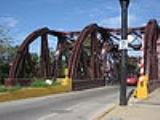
Cortland Street Drawbridge
Encyclopedia
The Cortland Street Drawbridge
(originally known as the Clybourn Place drawbridge) over the Chicago River
is the original Chicago-style fixed-trunnion bascule bridge
, designed by John Ericson and Edward Wilmann. When it opened in 1902 on the north side of Chicago
, it was the first such bridge built in the United States
. The bridge was a major advance in American movable bridge engineering, and the type was employed for over 50 additional bridges in Chicago alone. The bridge was designated as an ASCE
Civil Engineering Landmark in 1981, and a Chicago Landmark
in 1991.
design which was characterized by a mid-river pier for the swing span. The current (1902) bridge removed the requirement for the mid-river pier, leaving more room for ships.
While the machinery of the current bridge is intact, the bridge is no longer able to open and the leaves are clamped together in the center. The Cortland Bridge is currently still used for 2-way vehicle traffic, pedestrian, and bicycle traffic.
Drawbridge
A drawbridge is a type of movable bridge typically associated with the entrance of a castle surrounded by a moat. The term is often used to describe all different types of movable bridges, like bascule bridges and lift bridges.-Castle drawbridges:...
(originally known as the Clybourn Place drawbridge) over the Chicago River
Chicago River
The Chicago River is a system of rivers and canals with a combined length of that runs through the city of the same name, including its center . Though not especially long, the river is notable for being the reason why Chicago became an important location, as the link between the Great Lakes and...
is the original Chicago-style fixed-trunnion bascule bridge
Bascule bridge
A bascule bridge is a moveable bridge with a counterweight that continuously balances the span, or "leaf," throughout the entire upward swing in providing clearance for boat traffic....
, designed by John Ericson and Edward Wilmann. When it opened in 1902 on the north side of Chicago
Chicago
Chicago is the largest city in the US state of Illinois. With nearly 2.7 million residents, it is the most populous city in the Midwestern United States and the third most populous in the US, after New York City and Los Angeles...
, it was the first such bridge built in the United States
United States
The United States of America is a federal constitutional republic comprising fifty states and a federal district...
. The bridge was a major advance in American movable bridge engineering, and the type was employed for over 50 additional bridges in Chicago alone. The bridge was designated as an ASCE
American Society of Civil Engineers
The American Society of Civil Engineers is a professional body founded in 1852 to represent members of the civil engineering profession worldwide. It is the oldest national engineering society in the United States. ASCE's vision is to have engineers positioned as global leaders who strive toward...
Civil Engineering Landmark in 1981, and a Chicago Landmark
Chicago Landmark
Chicago Landmark is a designation of the Mayor of Chicago and the Chicago City Council for historic buildings and other sites in Chicago, Illinois, United States. Listed sites are selected after meeting a combination of criteria, including historical, economic, architectural, artistic, cultural,...
in 1991.
Design
This is the bridge type that Chicago engineers may be most famous for. The trunnion bascule has two bridge leaves hinged on opposing riverbanks. The bridge is drawn up by giant trunnion bearings. "Bascule" is French for "seesaw"; the bridge is named for the counterweights which balance the weight of the bridge leaves.History
This is the second bridge built on this site. The previous bridge was a swingSwing bridge
A swing bridge is a movable bridge that has as its primary structural support a vertical locating pin and support ring, usually at or near to its centre of gravity, about which the turning span can then pivot horizontally as shown in the animated illustration to the right...
design which was characterized by a mid-river pier for the swing span. The current (1902) bridge removed the requirement for the mid-river pier, leaving more room for ships.
While the machinery of the current bridge is intact, the bridge is no longer able to open and the leaves are clamped together in the center. The Cortland Bridge is currently still used for 2-way vehicle traffic, pedestrian, and bicycle traffic.

